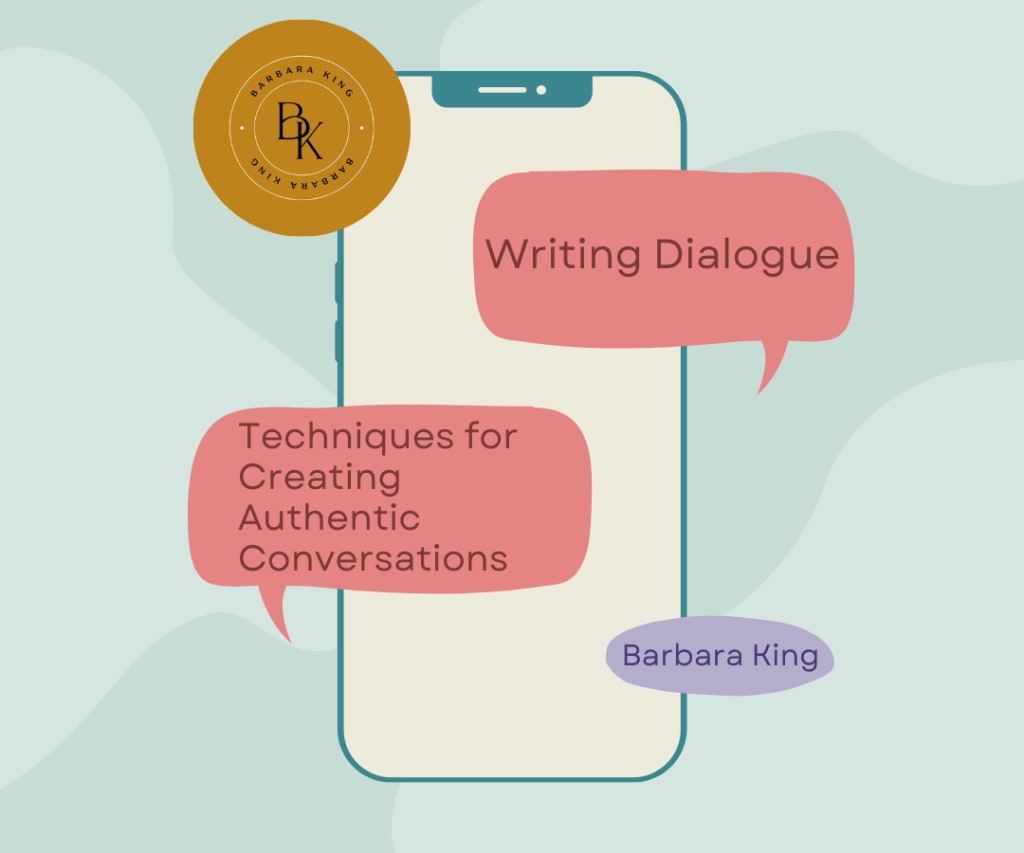Writing Dialogue
Techniques for Creating Authentic Conversations

When writing dialogue, it's important to create authentic conversations that feel natural and engaging for the reader, or else your reader might get thrown out of your story faster than if they had dropped the book into a pile of something that comes out of the back end of a cow.
Dialogue helps with character development, advancing your plot, creating tension and conflict, and enhancing the pace and flow of your novel.
I imagine reading a novel that has no dialogue would be like reading a history book or some other book from school that had me falling asleep waiting for the lunch bell to ring so I could go outside and read an actual book.
If you're struggling to write dialogue here are a few tips and tricks to try to help it flow more easily across the page.
Listen to real conversations:
One of the best ways to write authentic dialogue is to listen to how people talk in real life. Pay attention to the rhythm, tone, and word choices they use. This can help you create dialogue that sounds natural and realistic.
Or if you want better homework… watch your favorite show or really any show and have the captions on. This will give you the feeling of what it will be like to have dialogue in print and follow a flower of conversation.
Use contractions:
I once had a creative writing teacher tell the class that contractions weren't allowed to be used because they just sound wrong, but well - he was just wrong. Just because he didn't like the word can't instead of can not doesn't mean anything. If your character is a teenager asking their friend if they want to hang out after school they're not going to tell them, "No, I can not." They're going to say, " Nah, I can't."
In real life, people tend to use contractions when they speak. Using contractions in your dialogue can make it sound more natural and conversational.
Show, don't tell:
I hope you're not sick of this expression yet, if you want to be a writer you might as well print it out and tape it near your computer so that it's always on your mind.
Even though this article is about writing dialogue - not everything has to be dialogue.
When writing dialogue, it's important to show what's happening instead of just telling the reader. Instead of having a character say, "I'm angry," show them slamming a door or clenching their fists.
Or if they're anything like us drivers in New England, they're not just going to grip their wheel and let that Honda Civic cut them out - they're going to roll down the windows and tell that driver exactly what they think of their mother.
Use interruptions and pauses:
People don't always speak in complete sentences or wait for the other person to finish before speaking. Using interruptions and pauses in your dialogue can make it feel more realistic and natural.
Sarah: "I can't believe I got the job at the bakery. I've always wanted to work with pastries and…"
Jack: "Wait what? Did you say you got the job?"
Use dialect and slang sparingly:
While dialect and slang can add authenticity to your dialogue, using too much can be distracting and difficult for readers to understand. Use it sparingly and ensure it's appropriate for the character and setting.
Ralph: "Well, I reckon this joint ain't what it used to be. Back in the day, we'd have a real shindig, dancin' up a storm and cuttin' a rug. Now it's all jazzed up with these youngsters spoutin' jive talk and givin' me the heebie-jeebies."
John: "You said it, pal! These young cats are all wet, with their baloney and horse feathers. Can't carry a tune in a bucket and don't know a lick about class. It's a real drag, I tell ya."
While such dialogue can provide a sense of authenticity to the time and setting of the story, it may require readers to do some research or context-gathering to fully understand the intended meaning.
Avoid on-the-nose dialogue:
On-the-nose dialogue is when characters say exactly what they're thinking or feeling. This can make the dialogue feel forced and unrealistic. Your character isn't going to say, "I'm really angry at you right now. You broke your promise, and it hurt me deeply. I don't think I can trust you anymore." Unless your characters have perfect communication - this doesn't happen in real life. Instead, use subtext to convey what the character is thinking or feeling without saying it outright.
"John's face flushed, his jaw clenched, and his fists tightened at his sides. He took a step back, distancing himself from the other person. He avoided eye contact, his gaze fixed on the floor. "I thought we had an understanding. I guess some promises are meant to be broken."
---
Using these techniques, you can create authentic and engaging dialogue for your readers.
Best of luck and keep writing!
With love,
B.K xo
*If you've liked what you read you can show your support by subscribing, pledging your support, or leaving me a tip that directly supports and aids me as a writer.
By joining Vocal+ you can earn more per read on every story you publish on Vocal.
Click my link to start your 7-day free trial today and start earning more for your stories.
_____________________________________________
This story was originally posted on Medium.
If you would like to experience Medium yourself, consider supporting me and thousands of other writers by signing up for a membership. It only costs $5 per month, it supports us writers, greatly, and you have the chance to make money with your own writing as well. By signing up with this link, you'll support me directly with a portion of your fee, it won't cost you more. If you do so, thank you a million times!
If you love what you've read you can also show your support by buying me a cup of coffee to fuel my writing.
https://www.buymeacoffee.com/barbaraking
*Contains Affiliate Links
About the Creator
Barbara King
Barbara King is a full-time writing coach and novelist. King is a recent college graduate from Southern New Hampshire University where she earned her BA in Creative Writing.






Comments
There are no comments for this story
Be the first to respond and start the conversation.